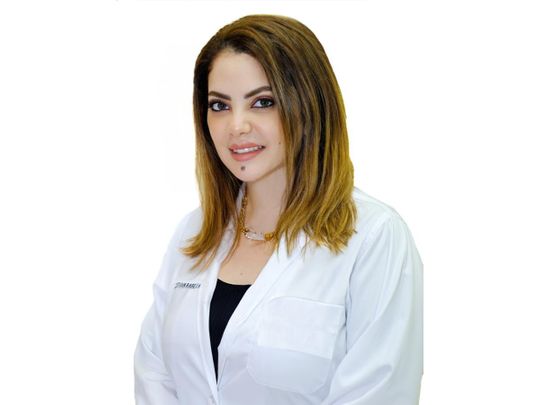
Pediatric dentist, Dr Eman Kalloub received a 9-year-old patient at her clinic as an emergency case with fracture and displacement of upper left labial maxillary bone, with loss of upper left lateral permanent incisor as the patient fell down while playing, causing this trauma.
“We’ve treated the case as a top priority, and set emergency steps in order to help the child get her smile back “ said Dr Eman.
She added, “Our emergency treatment plan was to put the patient under nitrous oxide sedation, apply local anesthesia to the area of trauma, followed by repositioning the fractured maxilla back to its original place with a surgical suturing for the torn gum, with irrigation of normal saline and cleaning the injured area.”
Dr Eman advised the patient’s family to stay and follow up for 3 weeks until the bone of the jaw and gum returned back to the normal position and the patient was able to remove the surgical suture in order to take new impressions and restore the upper permanent lateral incisor.
A further step taken by Dr Eman was to insert the appliance once ready, and explain to the patient and her parents on how to use and deal with it.
The patient’s mother expressed her appreciation on the success of the treatment that saved her daughter’s smile and admired the readiness of Dubai’s medical teams who possessed such high standards of knowledge and experience, and thanked Dr Eman in particular for heading the emergency treatment and chain of procedures with great success.
“It is a case where the patient lost her permanent tooth (completely avulsion), and hence was advised to keep the tooth in the water container (tap water), milk or even in the patient’s saliva until meeting the dentist,” Dr Eman explained.
She further added, “Keeping the tooth in a wet environment will save the tooth and its tissues (perio dontal ligaments) from dryness, so when the patient arrives at the clinic and after having local anesthesia administered, followed by cleaning the injured area, the dentist can reposition the tooth directly into place (Re-implant) and completely avulsed the permanent tooth to its place, before working on suturing the torn gum and fixing the tooth back to its location by using composite-orthodontic wire fixation appliance (Splinting) for 2 weeks.”
On the procedure taken after that, Dr Eman said it is critical to stabilise the tooth for 2 weeks using a passive flexible wire of a diameter up to 0.016 or 0.4mm and to keep the composite and bonding agents away from the gingival tissues and proximal areas. In case of having a fracture of the alveolar or jaw bone splinting, it should be in its place for 4 weeks, with the root canal treatment to be carried out in 2 weeks, as any delay in re-implantation of the avulsed tooth could lead to a poor long-term prognosis.
As a final step 2 weeks later, the patient went to check on whether the bone and tooth fixation was in its correct place, and got to remove the splinting and having the root canal treatment.
“It was my ultimate happiness to see her beautiful smile getting back to normal, and helping saving her teeth, which make the life of a dentist a real daily blessing, of being able to help kids getting a healthy perfect smile,” said Dr Eman, describing her feelings after the success of this critical case and the well-established treatment plan.












